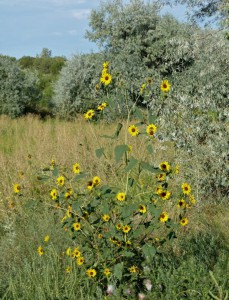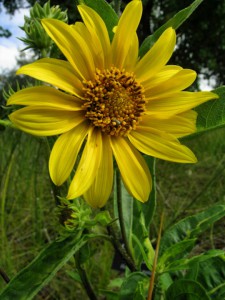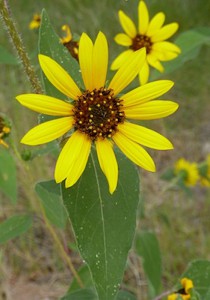
Helianthus annuus (Common sunflower) in field by Janice Tucker.
Scientific Name (Genus): Helianthus
Family: Asteraceae
Common name: Sunflowers
Article by Susan Bruneni
“At the dawn of creation, the spirits rushed to the edge of the world, to see the first sunrise. The sunflower spirits gathered together in the front. And when the sun first shone upon their beaming faces, he gave them a ray of his light to represent him on earth forever.”
anon Native American legend
The genus Helianthus originated in North America and is now found throughout the world. Of the 50 species, three are found at Leonora Curtin Wetland Preserve.
Helianthus annuus, common or annual sunflower
This very tall (5-12 feet) annual has rough, stout, hairy, red-splotched stems. It is the most common and widely used sunflower in the Southwest. It was cultivated by Native Americans as early as 2300 BC, and selectively bred to increase seed size and oil quality. The yellow blooms are three to five inches wide, ray and disk. They bloom August through September and are found at all three SFBG sites.
Helianthus nuttallii, Nuttall’s sunflower, Cordilleran sunflower

Helianthus nuttallii (Cordillerian Sunflower) by Janice Tucker.
This is a native perennial, with smooth to rough erect stems that grow two to 10 feet tall. Leaves are egg-shaped to lance-shaped. Helianthus nuttalli blooms July to September with two-inch flower heads. The species is named for early 19th-Century botanist and explorer Thomas Nuttall, who made many expeditions into the American Southwest.
Helianthus petiolaris, Prairie Sunflower, Plains Sunflower

Helianthus petiolaris (Prairie sunflower) by Janice Tucker
This is also an annual native, with many branched, erect hairy stems beginning at the base of the plant. Hairy leaves are mostly alternate, up to six inches long, lance-shaped to triangular-ovate and sometimes toothed on the margins. The leaf stalk is elongated. It grows best in sandy soil, reaches heights to five feet, and produces solitary flower heads (one-inch ray surrounding central reddish-purple disk flowers) from July to September .
Helianthus maximiliani Maximilian sunflower
Maximilian sunflower is also found throughout Santa Fe and Albuquerque, but is an introduced species native to the Eastern United States.
Uses of Helianthus annuus are extensive. Sunflower seed kernels are a rich source of vitamins and minerals and can be ground into meal for soup, mush or bread. Whole seeds can be roasted and ground as a substitute for coffee. Ground seeds are boiled for the oil that can be used for cooking or to moisturize skin. Medicinal uses include remedies for stomach aches, wart removal, poltices, worm elimination in humans and animals and many additional applications. Leaves of the sunflower can be used as cattle feed, while the stems contain a fiber now used in paper production. Because the sunflower is a traditional symbol of courage, warriors would carry sunflower cakes into battle or a hunter would sprinkle sunflower powder on his clothing to keep his spirit up.
A yellow dye is made from the petals and a black or purple dye is made from the seeds. The flowers within the disk are arranged in a complex spiral pattern, duplicated in Native American basketry patterns.
Sunflower seeds were brought from the Americas to Europe in the 16th Century and the plants were widely prized for their blooms. But the Russian Orthodox Church commercialized their value as a food source because the oils met certain qualifications for religious restrictions. Russia began cultivating the plants and producing the oil in mass. Today sunflowers are cultivated world-wide. The Dakotas are the largest producing area in the United States.
The sunflower is celebrated in New Mexico at late-August festivals. Mountainair Sunflower Festival includes a sunflower hat contest, sunflower cook-off, arts and crafts related to sunflowers and a grand array of sunflowers in bloom. The New Mexico State Fair includes a category for the largest sunflower (the dried seed-heads are judged).
In Pena Blanca (between Santa Clara and Cochiti Pueblos), experimental fields are producing a cultivated hybrid of Helianthus annuus, one of the first commercial sites in the state. Their first annual Sunflower Festival was held in August. Cultivated sunflowers are also a natural crop to replenish depleted soil in the many local alfalfa fields.
Whatever the important uses of sunflowers are for consumption, there is nothing more satisfying than to be greeted by a row of these native plants, happily watching you from behind a fence or waving to you from a roadside – sharing their ray of sunshine.


